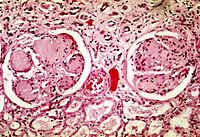
Photo from wikipedia
Lipid profile abnormalities have been reported to be associated with cardiometabolic diseases, but it is not fully known whether lipid profile abnormalities are prospectively associated with the risk of proteinuria… Click to show full abstract
Lipid profile abnormalities have been reported to be associated with cardiometabolic diseases, but it is not fully known whether lipid profile abnormalities are prospectively associated with the risk of proteinuria in subjects with impaired fasting glucose (IFG) or type 2 diabetes. Study subjects included 3801 Japanese men aged 40-55 years who had fasting plasma glucose ≥100 mg/dL, no proteinuria, eGFR ≥60 mL/min/1.73 m2, and no history of cancer and were not taking antihypertensive, lipid-lowering, and hypoglycemic medications at baseline. The incidence of proteinuria was defined as “consecutive proteinuria” if it was detected twice consecutively as 1+ or higher on urine dipstick during the follow-up periods to exclude chance proteinuria as much as possible. Triglycerides, HDL-cholesterol, non HDL-cholesterol, and LDL-cholesterol levels were obtained at baseline. During the 11-year follow-up period, we confirmed 221 cases of proteinuria. In Cox proportional-hazards analysis, higher level of triglycerides increased the risk of proteinuria and higher level of HDL-cholesterol decreased the risk of proteinuria. After adjustment for age, eGFR, fasting plasma glucose, hypertension status, alcohol consumption, regular physical activity, and smoking status, hazard ratios (HRs) for triglycerides levels of 100-149, 150-199, and ≥200 mg/dL were 1.07 (95% CI, 0.73-1.55), 1.22 (0.80-1.84), and 1.47 (1.01-2.13), respectively, compared with In conclusion, higher level of triglycerides increased the risk of incident consecutive proteinuria and higher level of HDL-cholesterol decreased it in the middle-aged Japanese men with IFG or type 2 diabetes. Disclosure S. Uehara: None. K. Sato: None. M. Shibata: None. K. Oue: None. H. Kambe: None. M. Morimoto: None. T. Hayashi: None.
Journal Title: Diabetes
Year Published: 2018
Link to full text (if available)
Share on Social Media: Sign Up to like & get
recommendations!